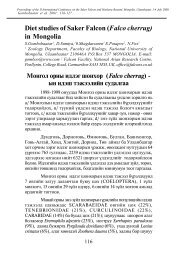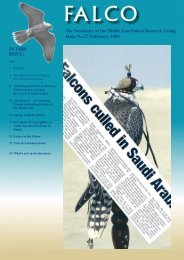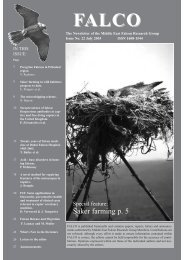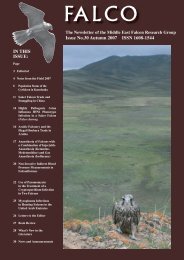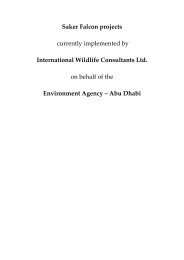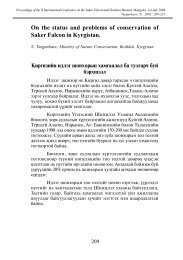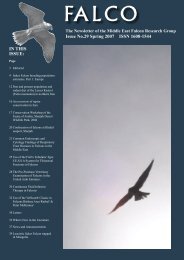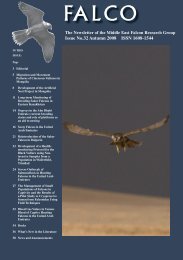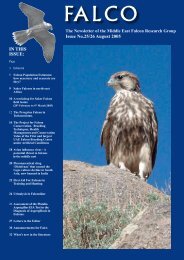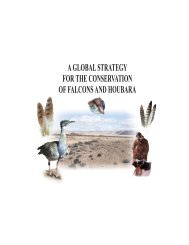case we described ChE activity was depressed by 245%compared to the value 20 days after treatment, and by290% compared to the value measured in a captive griffonvulture (Gyps fulvus) tested the same day.TreatmentSpecific treatment relies on the administration of atropinesulfate that blocks the muscarinic effects at the nervesynapsis. Dosage of 1% atropine sulfate administeredintramuscularly is 0.5 mg/kg (Porter 1993). A higher dosagecan be used according to the severity of clinical signs.We used about 1 mg/kg upon arrival as an initial dose inthe lappet-faced vulture we treated, and then 0.5 mg/kg atday 3. Improvement was immediate and spectacular. Othersymptomatic and supportive treatment should also be provided.ConclusionPopulations of India’s commonest Gyps vultures haverecently dramatically declined due to a mysterious disease(Prakash 1999). Sick birds appeared lethargic withdrooping heads and wings, all symptoms compatible witha ChE poisoning in bird. However, recent investigationsseem to have ruled out anti-ChE pesticides as the cause ofthe disease and instead point towards an infectious cause(Prakash et al. 2002). People have conceived that the diseasethat seem to affect all Gyps vultures could spreadfrom South Asia throughout the Middle East and the OldWorld (Prakash et al. 2002). It is important therefore thatveterinarians throughout the Middle East play a role ofepidemiological sentinels and investigate to the best oftheir capacities any sick vulture with a lethargy syndrome.Should any case arise, anti-ChE poisoning will have to beruled out.References:Dumonceaux, G., & Harrison, G. J. (1994) Toxins. InAvian Medicine: Principles and Applications. B. W.Ritchie, G. J. Harrison, and L. R. Harrison (eds.). WingersPublishing, Lake Worth, USA, pp. 1049-1051.Fairbrother, A., & Bennett, J. K. (1988) Usefulness ofcholinesterase measurements. Journal of <strong>Wildlife</strong> Diseases.24: 587-590.Hill, E. F. (1988) Brain cholinesterase activity of apparentlynormal wild birds. Journal of <strong>Wildlife</strong> Diseases. 24:51-61.West Yorkshire, England, pp. 143-151.Lumeij, J. T., Smit, T. & Spierenburg, T. J. (1993)Diagnosis and treatment of poisoning in raptors from theNetherlands: Clinical case reports and review of 2,750postmortem cases, 1975-1988. In: Raptor Biomedicine.P. T. Redig, J. E. Cooper, J. D. Remple & D. B. Hunter(eds.). University of Minnesota Press, Minneapolis, USA,pp. 233-238.Mendelssohn, H., & Paz, U. (1977) Mass mortality ofbirds of prey caused by azodrin, and organophosphorousinsecticide. Biological Conservation. 11: 163-170.Meerdink, G. L. (1989) Organophosphorous and carbamateinsecticide poisoning. In Current VeterinaryTherapy, vol. 10, R. W. Kirk (ed.). W. B. Saunders,Philadelphia, Pennsylvania, pp. 135-137.Ostrowski, S., & Shobrak, M. (2001) Pesticide poisoningin a free-ranging lappet-faced vulture (Torgos tracheliotus).Veterinary Record. 149: 396-397.Porter, S. (1987) Pesticide use in Virginia. In <strong>Wildlife</strong>rehabilitation, D. J. Mackey (ed.). Coconut Creek publishing,Coconut Creek, Florida, pp. 39-42.Porter, S. (1993) Pesticide poisoning in birds of prey.In: Raptor Biomedicine. P. T. Redig, J. E. Cooper, J. D.Remple & D. B. Hunter (eds.). University of MinnesotaPress, Minneapolis, USA, pp. 239-245.Prakash, V. J. (1999) Status of vultures in KeoladeoNational Park, Baratpur, Rajasthan, with special referenceto population crash in Gyps species. Journal of theBombay Natural History Society. 96: 365-378.Prakash, V. J., Pain, D. & Cunningham, A. (2002) No respitefor India’s vultures. World Birdwatch. 24: 14-15.Smith, G. (1987) Pesticide use and toxicology in relationto wildlife: organophosphorous and carbamate compounds.U.S. Fish and <strong>Wildlife</strong> Service, Resource Publication No.170. U.S. Government Printing Office, Washington, D.C.Steedman, A. (1988) Locust handbook. A. Steedman(ed.). Overseas Development Natural Resources Institute,London, U.K.Hill, E. F. & Fleming, W. J. (1982) Anticholinesterasepoisoning of birds: field monitoring and diagnosis of acutepoisoning. Environmental Toxicology and Chemistry. 1:27-38.Humpheys, D. J. (1988) Veterinary Toxicology. 3rd edn.Baillère Tindall, London, U.K., pp. 129-182.Keymer, I. F., Fletchner, M. R. & Stanley, P. I. (1981)Causes of mortality in British kestrels. In: RecentAdvances in the Study of Raptor Diseases. J. E. Cooper& A. G. Greenwood (eds.). Chiron Publishing, Keighley,9
Catastrophic Declines of Griffon Vultures in IndiaA. A. Cunningham 1 , D. Pain 2 & V. Prakash 31 Head of <strong>Wildlife</strong> Epidemiology, ZSL Institute ofZoology, Regent’s Park, London, NW1 4RY, U.K.2 Debbie Pain, Royal Society for the Protection ofBirds, The Lodge, Sandy, Bedfordshire SG19 2DL,U.K.3 Principal Scientist, Bombay Natural History Society,Hornbill House, Shaheed Bhaagat Singh Road,Mumbai 400 023, IndiaIn 1996, Dr Vibhu Prakash of the Bombay NaturalHistory Society (BNHS) published a paper (Prakash1999) describing the rapid and marked decline of theIndian white-backed (Gyps bengalensis) and Indian longbilled(Gyps indicus) vultures in the Keoladeo NationalPark (KNP, World Heritage Site), Rajasthan, India.Nation-wide surveys conducted by the BNHS, with supportfrom the Royal Society for the Protection of Birds(RSPB), showed that similar (>90%) declines of bothspecies had occurred throughout India between the early1990s and 2000 (Prakash et al. in press). Both affectedspecies were once regarded as very common in India, butnow they are listed as critically endangered by the IUCN.Dr Prakash had noted that many Gyps spp. vultures inand around KNP appeared sick with intermittent, oftenprolonged periods of head drooping. Such birds inevitablydied and the mortality rate of these species in KNPwas extremely high. During the nation-wide surveys,vultures across the country appeared lethargic and sickwith drooping heads. Dead birds were frequently found.Other species of scavenger, including non-Gyps vultureswere not affected at KNP. This situation held true for allareas surveyed throughout India. In fact, apart from therapidity and extent of the declines, the most remarkableaspect is that only Gyps spp. appear to be affected.Initially poisoning, persecution and a lack of food wereconsidered as possible causes of the declines, as is oftenthe case for vulture mortality incidents elsewhere. Asreported for KNP (Prakash 1999), food appeared to beabundant throughout the country and few livestock carcasseshad attendant vultures (Prakash et al. in press).Examination of vulture tissues for exposure to pesticidesand other poisons have, so far, drawn a blank (Oaks et al.2001; Rahmani & Prakash 2000) and there is no evidenceor culture of persecution of vultures in India. The genusspecificnature of the causative agent, along with the lackof a biogeographic patchiness (e.g. similar declines inurban vs rural, protected areas vs agricultural areas) tothe vulture declines and mortality, implies that the causeis likely to be more insidious than any initially proposed.The pattern is consistent, for example, with that of aninfectious disease epidemic, such as occurred in ungulateswhen rinderpest was introduced into Africa.2001 the RSPB, BNHS and ZSL’s Institute of Zoologyobtained grant funding from the UK Government’s DarwinInitiative for the Survival of Species and initiated a systematicinvestigation into the cause of the vulture declines.This has involved setting up a Vulture Disease InvestigationLaboratory as a sub-section of an established avian diagnosticlaboratory in India, and obtaining freshly-dead vulturesfor post mortem examination. Obtaining such carcases hasnot been an easy affair, and a large number of people havespent a great deal of time occupied with this aspect of thework. To date, we have examined 30 carcases in detail,comprising both long-billed and white-backed vultures,adults and juveniles. We have been very fortunate in thisendeavour to have access to the staff and facilities of thePoultry Diagnostic and Research Centre (PDRC) in India,without which the provision of follow-up diagnostic testswould not have been possible.The results so far have shown that many of the birds diedwith evidence of enteritis and of severe renal and visceralgout. Although renal gout is often attributed to kidney disease,in these cases the gout has been extensive and acute(or peracute) - i.e. occurring only a few hours (or less)before death. This condition is, therefore, a consequenceof the primary disease and not the disease itself. It is mostlikely a response to terminal dehydration of the affectedbird, although we have not yet been able to prove this.Apart from the gout and enteritis, there has been remarkablylittle to see at gross post mortem examination of affectedvultures, although microscopic tissue examination revealedthat lymphocytes (a type of white blood cell) had migratedfrom blood vessels, often an indication of a reaction to aninfectious disease.In addition to the post mortem investigations, money fromthe Darwin Initiative is being used to build and staff a“Vulture Care Centre” in India. Sick birds will be housedin this Centre in order to learn more about the disease andto try to bring about a recovery via veterinary interventions.The National Bird of Prey Centre in the UK, specialistsin raptor care in captivity, are advisors to this part of theproject. Also, for the three years of the Darwin funding,India-wide population surveys and health surveillance willbe carried out, so the progress of the problem in India canbe carefully monitored. The ultimate aim of this work is toproduce a vulture recovery plan.Although the initial findings from our investigations are tantalising,they do not yet provide an answer as to the cause ofthe disease killing the vultures. Work is on-going both (1)specifically aimed at identifying a viral cause of the disease,as suggested by the diagnostic investigation so far, and (2)broadly aimed at identifying any possible cause of the birds’demise - infectious or non-infectious. We are keeping ourdiagnostic minds as open as possible because, although ourfindings are suggestive of a viral involvement, this may notbe the case or, if so, it may only be part of the story.Prompted by these dramatic and worrying findings, in10



